Getting to know Cloud Armor — defense at scale for internet-facing services
Prajakta Joshi
Sr. Product Manager, Cloud Networking
We know that you have the tough job of quickly and responsively serving your users, while also simultaneously defending your internet-facing services from malicious attacks. That’s why we announced Cloud Armor, a new DDoS and application defense service, at the CEO Security Forum in New York last week. It’s based on the same technologies and global infrastructure that we use to protect Google services like Search, Gmail and YouTube.
Economy of scale
Our security experts work around the clock to defend Google’s core services from a wide variety of malicious attacks. Metrics from DDoS attacks targeting Google services over the past decade reveal attack volumes have increased exponentially across several axes: bits per second (bps), packets per second (pps) and HTTP(S) queries per second (qps).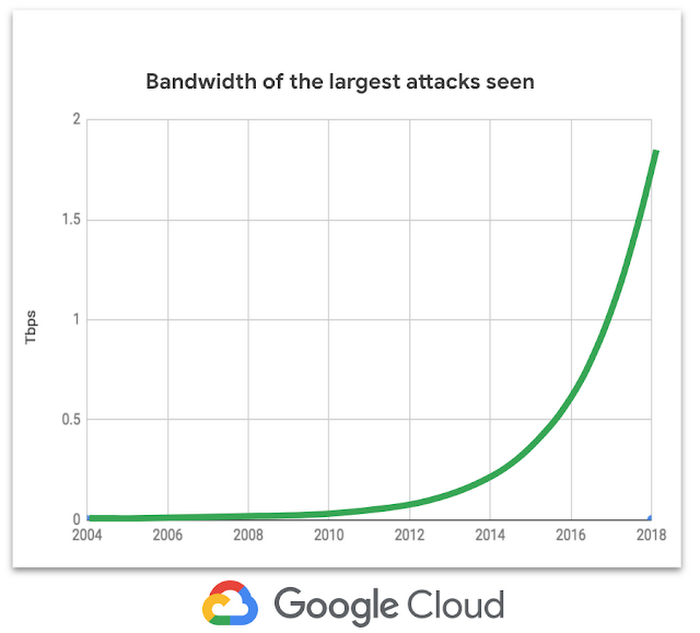

Absorbing the largest attacks requires the bandwidth needed to watch half a million YouTube videos at the same time... in HD.
Dr. Damian Menscher, DDoS Defense, Google
To defend against this threat, we deploy edge infrastructure and security systems to mitigate attacks targeting our services—and this same infrastructure underpins Google Cloud. With global HTTP(S) load balancing, the first Google Cloud Platform (GCP) service to support Cloud Armor, you get built-in defense against infrastructure DDoS attacks. No additional configuration, other than to configure load balancing, is required.
Defense is a collaborative effort.
We work closely with several industry groups to track emerging threats, allowing us to both protect ourselves and others. In addition, we host krebsonsecurity.com and other frequent targets to ensure we are among the first to see new attack methods. This lets us design defenses and dismantle botnets before they have a chance to grow.
Dr. Damian Menscher, DDoS Defense, Google
Sharing resources across Google and Google Cloud services allows us to easily absorb the largest attacks, and also ensure that an attack on one customer doesn’t affect others.
Cloud Armor: Policy driven application defense at scale
Cloud Armor works in conjunction with global HTTP(S) load balancing and enables you to deploy and customize defenses for your internet-facing applications. Similar to global HTTP(S) load balancing, Cloud Armor is delivered at the edge of Google’s network, helping to block attacks close to their source. It's built on three pillars: a policy framework, a rich rules language and global enforcement infrastructure.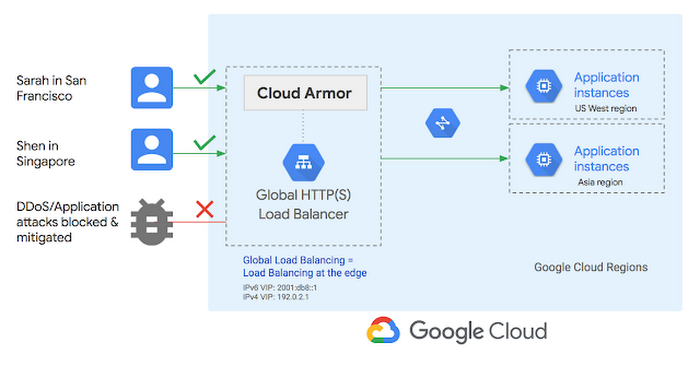

Cloud Armor is a great example of how Google continues to innovate on its pervasive defense-in-depth security strategy, providing a rich layer of security control that can be managed at the network edge.
Matt Hite, Network Engineer, Evernote
Cloud Armor features and functionality
With Cloud Armor, you can:- defend your services against infrastructure DDoS attacks via HTTP(S) load balancing
- configure security policies, specify rules and order of evaluation for these rules
- allow, block, preview and log traffic
- deploy IP whitelists and blacklists for both IPv4 and IPv6 traffic
- create custom rules using a rich rules language to match traffic based on any combination of Layer 3 and HTTP(S) request parameters and allow or block this traffic (in alpha)
- enable geolocation-based control, and application-aware defense for SQL Injection (SQLi) and Cross-site Scripting (XSS) attacks (in alpha)
Cloud Armor Security policy framework
Cloud Armor configuration is driven by security policies. To deploy Cloud Armor, you must create a security policy, add rules, and then attach this policy to one or more HTTP(S) load balancing backend services.A Cloud Armor security policy is comprised of one or more rules, where each rule specifies the parameters to look for in the traffic, the action to take if the traffic matches these parameters, and a priority value that determines the position of this rule in the policy hierarchy.
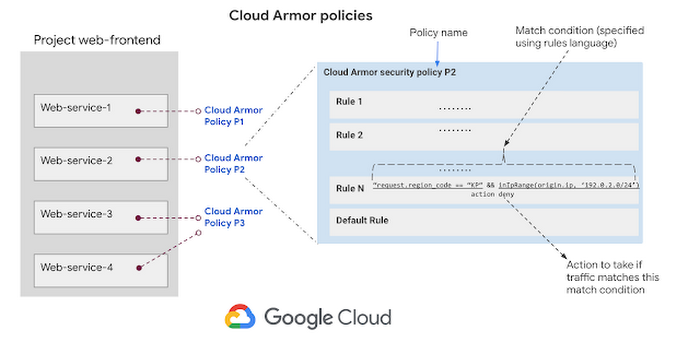

Cloud Armor allows you to create multiple policies per project. You can customize the defense for a subset of backend services by creating a policy specifically for these services.
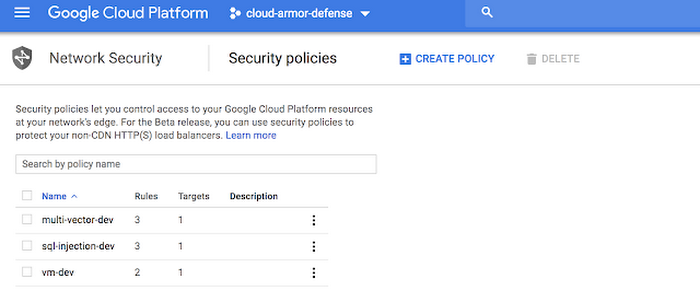

Below, we show how to configure IP Blacklists and whitelists using Cloud Armor:
Cloud Armor Rules Language (in alpha)
Cloud Armor rules language enables you to customize defenses for your specific requirements. Often attackers use multiple well-known and custom malicious patterns to attempt bringing your service down. Custom rules enable you to configure specific attack patterns to look for in the traffic and then block this traffic at scale.Here’s an example of a custom rule to defend against an attack seen to be originating from US and containing a specific cookie and user-agent.
Configuration using gCloud CLI:
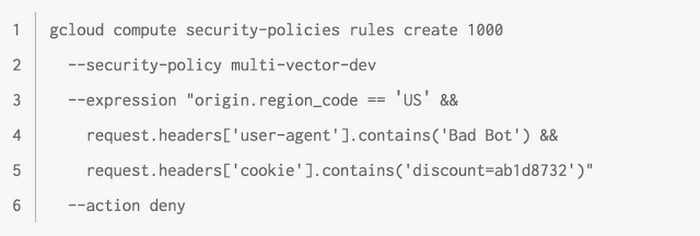

Configuration using console:
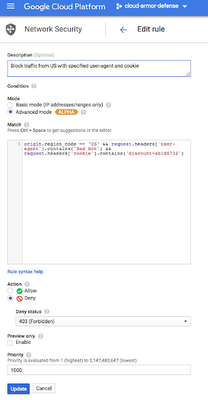

For the most common application-aware attacks, Cloud Armor provides two pre-configured rules: Cross-site Scripting (‘xss-canary’) and SQL Injection (‘sqli-canary’) defenses. In the example below, we configure an SQL injection defense rule in policy “sql-injection-dev” using gCloud CLI:


Below, you can see the SQLi defense rule, along with other rules, in the policy:
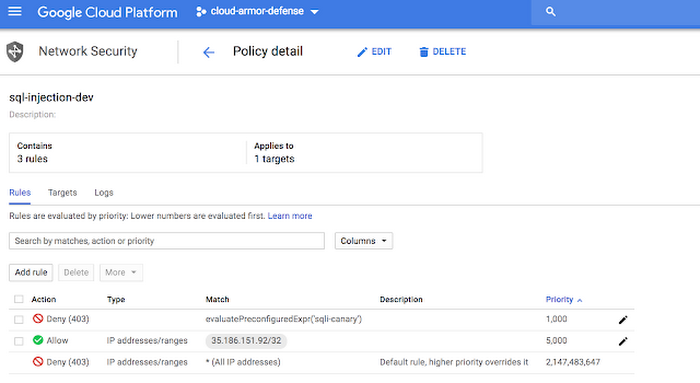

You can request Alpha access to these features by signing up using this form.
Visibility into blocked and allowed traffic
You can view the allowed and blocked traffic in Stackdriver as shown below: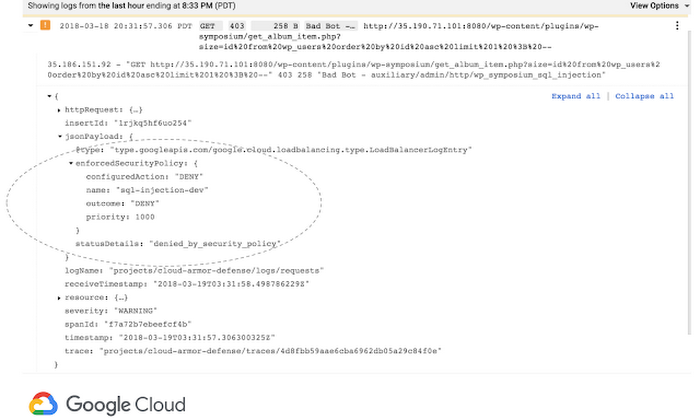

Partner ecosystem
We have a rich ecosystem of security providers who offer solutions that complement Cloud Armor’s capabilities. You can use these in conjunction with global HTTP(S) load balancing and Cloud Armor to build a comprehensive security solution. Learn more about our security partners here.Get started today
Cloud Armor is for everyone deploying internet-facing services in Google Cloud. Learn more by visiting the Cloud Armor website. We look forward to your feedback!Editor’s note: As of November 2018, Cloud Armor whitelists and blacklists are now referred to as allow lists and deny lists.


